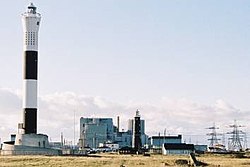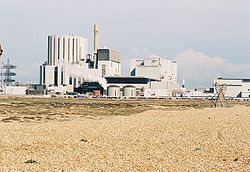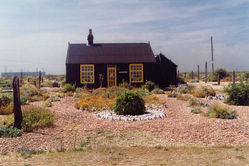Dungeness
Dungeness is a headland on the south coast of Kent, at TR0917, formed largely of a shingle beach in the form of a cuspate foreland. It is the triangular jut of land sticking out into the English Channel just east of the Sussex border. Dungeness shelters a large area of low-lying land, Romney Marsh.
Dungeness is also the name given to a hamlet found along the beach; no more than a scattering of dwellings.
The Romney, Hythe and Dymchurch Railway, opened to New Romney in 1927, was extended to Dungeness a year later, and continues to operate.
Contents
Name
The name Dungeness derives from Old English næs, meaning "headland", with the first part probably connected with the nearby Denge Marsh. Popular etymology ascribes a French origin to the name, giving an interpretation as "dangerous nose".
Landscape
The landscape is of relatively recent late mediæval origin and was further altered when the marsh was drained and replaced by the large arable fields of industrial agriculture.[1]
The Dungeness area will potentially be affected by plans to lengthen the runway of London Ashford Airport to accommodate large passenger jets.
Nature
Dungeness is one of the largest expanses of shingle in the world. It is of international conservation importance for its geomorphology, plant and invertebrate communities and birdlife. This is recognised and protected mostly through its conservation designations as a National Nature Reserve (NNR), a Special Protection Area (SPA), a Special Area of Conservation (SAC) and part of the Site of Special Scientific Interest (SSSI) known as "Dungeness, Romney Marsh and Rye Bay".
There is a remarkable and unique variety of wildlife living at Dungeness, with over 600 different types of plant (a third of all those found in Britain). It is one of the best places in Britain to find insects such as moths, bees and beetles, and spiders; many of these are very rare, some found nowhere else in Britain.
The short-haired bumblebee, declared extinct in the United Kingdom nearly a decade ago, but which has survived in New Zealand after being shipped there more than 100 years ago, is to be reintroduced at Dungeness. It is planned that the first bees will be introduced in the spring of 2010.
The flooded gravel pits, both brackish and fresh water, provide an important refuge for many migratory and coastal bird species. The RSPB has a bird sanctuary there and every year thousands of bird watchers descend on the peninsula to catch a glimpse of a rare bird from the bird observatory.
One of the most remarkable features of the site is an area known as 'the patch' or, by anglers, as 'the boil'. The waste hot water and sewage from the Dungeness nuclear power stations are pumped into the sea through two outfall pipes, enriching the biological richness of the sea bed and attracting seabirds from miles around.
Lighthouses
There have been five lighthouses at Dungeness:
- At first only a beacon was used to give warning to sailors
- In 1615 under King James I this gave way to a proper lighthouse
- In 1635, as the sea had retreated, the Jacobean lighthouse was replaced by a new one nearer the water’s edge.
- In 1792, as more shingle had been thrown up, a new and more up-to-date lighthouse was built near the sea
- In 1901 a new lighthouse was commissioned.
- In 1961 a modern successor lighthouse was commissioned, painted in striking black and white.
The Old Lighthouse (of 1901) became a tourist attraction. Its 169 steps give visitors a bird’s eye view of the shingle beach.
Power stations
There are two nuclear power stations at Dungeness, built in 1965 and in 1983. They are within a wildlife sanctuary deemed a Site of Special Scientific Interest and birds flourish in the warmer water created by the stations' warm outflow.
The older station, Dungeness A, closed on 31 December 2006,[2] while Dungeness B has had its licence extended to 2018.[3]
Defence uses
The beach and marshes have been used for military training and there are marked Danger areas.
Acoustic mirrors
Denge is the site of a set of acoustic mirrors, known as the "Listening Ears". Built between 1928 and 1930, the three massive concrete structures formed an experimental early warning system that aimed to detect invading aircraft by focusing sound waves. The site was chosen as being one of the quietest in Britain. Their different forms are evidence of their experimental nature; they were not particularly effective and were abandoned when radar became available. English Heritage and English Nature have joined forces to provide public access to the site.
Operation Pluto
In 1944 some of the world's first submarine oil pipelines were laid between Dungeness and France in Operation Pluto. The lines from Dungeness were part of a network called Dumbo and ran to Ambleteuse in France.
The "Village"
Dungeness is not truly a village, more a scattered collection of dwellings. Some of the homes, small wooden houses in the main, many built around old railway coaches, are owned and lived in by fishermen, whose boats lie on the beach; some are occupied by people trying to escape the pressured outside world. The shack-like properties have a high value on the property market.
Perhaps the most famous house is Prospect Cottage, formerly owned by the late artist and film director Derek Jarman. The cottage itself is painted black, with a poem, part of John Donne's "The Sunne Rising", written on one side in black lettering. The garden however is the main attraction. Reflecting the bleak, windswept landscape of the peninsula, Derek Jarman's garden is made of pebbles, driftwood, scrap metal and a few hardy plants. A book, Derek Jarman's Garden, has been written about it.[4]
The Village has two Public Houses "The Pilot" and "The Britannia", both serving seafood. There are more solidly-built houses around the site of the power stations. Fresh seafood can be purchased from several outlets across the shingle.
Outside links
| ("Wikimedia Commons" has material about Dungeness) |
- Dungeness.org.uk
- Lovedungeness.org
- dungeness-nnr.co.uk Dungeness National Nature Reserve
- Dungeness Bird Observatory
- Images of Prospect Cottage on SlowMotionAngel.com
- Romney Marsh & Dungeness news & community website
- Dungeness acoustic mirrors
- Dungeness RNLI lifeboat
- Images of Dungeness
- PROSPECT - Dungeness-based art installation
References
- ↑ Liverpool University and Romney Marsh Research Trust web site linking ecology, geomorphology and human history in an accessible format for the non-specialist.
- ↑ "England | Kent | Nuclear switch-off at Dungeness A". BBC News. 2006-12-31. http://news.bbc.co.uk/1/hi/england/kent/6203953.stm. Retrieved 2009-06-02.
- ↑ "News". British Energy. http://www.british-energy.com/article.php?article=99. Retrieved 2009-06-02.
- ↑ Derek Jarman's Garden, ISBN 0-500-01656-9




